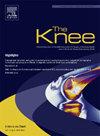Lower extremity joint kinematics in individuals with and without bilateral knee osteoarthritis during normal and narrow-base walking: A cross-sectional study
IF 1.6
4区 医学
Q3 ORTHOPEDICS
引用次数: 0
Abstract
Background
Knee osteoarthritis (KOA) is a prevalent musculoskeletal disease affecting joint mechanics. Considering the effect of step-width changes on the biomechanics of gait, especially the alteration of stability dynamics during narrow-base gait, this study investigated the kinematic parameters of the lower extremities during both normal and narrow-base walking in individuals with and without KOA.
Methods
A cross-sectional study with 20 individuals with bilateral KOA and 20 controls was conducted. Participants walked on a treadmill at a preferred speed across normal and narrow paths. Joint angles and angular velocities in the sagittal and frontal planes were recorded, and mixed ANOVA was used to analyze group × condition effects.
Results
Significant main effects of walking condition were observed for hip (p = 0.001) and ankle angles (p = 0.002) in the frontal plane, and knee (p = 0.004) and ankle angular velocities (p = 0.002) in the sagittal plane. Moreover, there were significant main effects of group on the hip (p = 0.01) and knee angles (p = 0.04) in the sagittal plane. KOA group showed higher peak hip adduction (p < 0.001) and ankle inversion (p = 0.02]) during narrow-base walking than on the normal path. People with KOA had also significantly higher peak angular velocity of knee flexion (p = 0.03), ankle dorsiflexion (p = 0.002), and ankle inversion (p = 0.03) during narrow-base walking.
Conclusions
The findings suggest that KOA and narrow-base gait challenges may trigger distinct kinematic adaptation strategies, potentially contributing to cartilage degeneration and altering balance mechanisms.
有或无双侧膝骨关节炎的个体在正常和窄基行走时的下肢关节运动学:一项横断面研究。
背景:膝关节骨关节炎(KOA)是一种影响关节力学的常见肌肉骨骼疾病。考虑步宽变化对步态生物力学的影响,特别是窄基步态时稳定性动力学的改变,本研究研究了有和无KOA个体正常行走和窄基行走时的下肢运动学参数。方法:对20例双侧KOA患者和20例对照患者进行横断面研究。参与者在跑步机上以自己喜欢的速度在正常和狭窄的道路上行走。记录关节矢状面和关节面角速度,并采用混合方差分析分析x组条件的影响。结果:行走条件对髋关节(p = 0.001)和踝关节角(p = 0.002)在正位面,膝关节(p = 0.004)和踝关节角速度(p = 0.002)在矢状面有显著的主要影响。此外,两组患者髋部(p = 0.01)和膝关节矢状面角度(p = 0.04)均有显著的主效应。结论:研究结果表明,KOA和窄基步态挑战可能引发不同的运动学适应策略,可能导致软骨退变和平衡机制改变。
本文章由计算机程序翻译,如有差异,请以英文原文为准。
求助全文
约1分钟内获得全文
求助全文
来源期刊

Knee
医学-外科
CiteScore
3.80
自引率
5.30%
发文量
171
审稿时长
6 months
期刊介绍:
The Knee is an international journal publishing studies on the clinical treatment and fundamental biomechanical characteristics of this joint. The aim of the journal is to provide a vehicle relevant to surgeons, biomedical engineers, imaging specialists, materials scientists, rehabilitation personnel and all those with an interest in the knee.
The topics covered include, but are not limited to:
• Anatomy, physiology, morphology and biochemistry;
• Biomechanical studies;
• Advances in the development of prosthetic, orthotic and augmentation devices;
• Imaging and diagnostic techniques;
• Pathology;
• Trauma;
• Surgery;
• Rehabilitation.
 求助内容:
求助内容: 应助结果提醒方式:
应助结果提醒方式:


